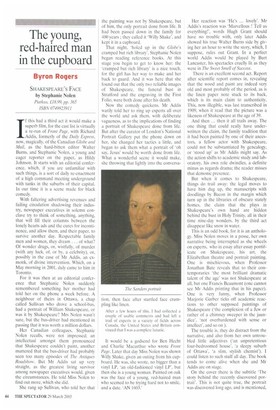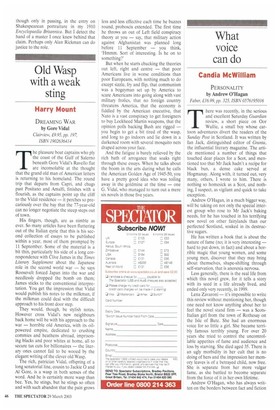The young, red-haired man in the cupboard
Byron Rogers
SHAKESPEARE'S FACE by Stephanie Nolen Piatkus, 1:18.99, pp. 365 ISBN 0749923911
If this had a third act it would make a superb film, for the cast list is virtually a re-run of Front Page, with Richard Addis, formerly of the Daily Express, now, magically, of the Canadian Globe and Mail, as the hard-bitten editor Walter Burns, and Stephanie Nolen, a young and eager reporter on the paper, as Hildy Johnson. It starts with an editorial conference, which, if you are unfamiliar with such things, is a sort of daily re-enactment of a high command meeting underground with tanks in the suburbs of their capital. In our time it is a scene made for black comedy.
With faltering advertising revenues and failing circulation shadowing their industry, newspaper executives in solemn conclave by to think of something, anything, that will fill their columns between the lonely hearts ads and the cures for incontinence, and allow them, and their paper, to survive another day. Respectable family men and women, they dream . , . of what? Of wonder drugs, or, wistfully, of murder (with any luck, of, or by, a celebrity), or, possibly in the case of Mr Addis, an exmonk, of divine intervention. Which, on a May morning in 2001, duly came to him in Toronto.
For it was then at an editorial conference that Stephanie Nolen suddenly remembered something her mother had told her on the phone a week before. A neighbour of theirs in Ottawa, a chap called Sullivan who drove a school-bus, had a portrait of William Shakespeare, or was it by Shakespeare? Mrs Nolen wasn't sure, but the bus-driver had mentioned in passing that it was worth a million dollars.
Her Canadian colleagues, Stephanie Nolen recalls, were not impressed; an intellectual amongst them pronounced that Shakespeare couldn't paint, another muttered that the bus-driver had probably seen too many episodes of The Antiques Roadshow. But Mr Addis sat up very straight, as the greatest living survivor among newspaper executives would, given the circumstances. He told Miss Nolen to find out more, which she did.
She rang up Sullivan, who told her that the painting was not by Shakespeare, but of him, the only portrait done from life. It had been passed down in the family for 400 years ; they called it 'Willy Shake', and kept it in a cupboard.
That night, 'holed up in the Globe's cramped but rich library', Stephanie Nolen began reading reference books. At this stage you begin to get to know her: the 'cramped but rich library' is a nice touch, for the girl has her way to make and her back to guard. And it was here that she found out that the only two reliable images of Shakespeare, the funeral bust in Stratford and the engraving in the First Folio, were both done after his death.
Now the comedy quickens. Mr Addis warily told her to ring up experts all over the world and ask them, with deliberate vagueness, as to the implications of finding a portrait of Shakespeare done from life. But after the curator of London's National Portrait Gallery put the phone down on her, she changed her tactics a little, and began to ask them what a portrait of 'oh say, Jesus' would be worth done from life. What a wonderful scene it would make, she throwing that lightly into the conversa tion, then face after startled face crumpling like linen.
After a few hours of this, I had collected a couple of usable comments and had left a trail of experts in a variety of fields across Canada, the United States and Britain convinced that I was a complete lunatic.
It would be a godsend for Ben Hecht and Charlie Macarthur who wrote Front Page. Later that day Miss Nolen was shown Willy Shake, given an outing from his cupboard. He was, she wrote, no bigger than a vinyl LP, 'an old-fashioned vinyl LP', but then she is a young woman. Painted on oak was the face of a young, red-haired man who seemed to be trying hard not to smile, and a date. 'AN 1601'
Her reaction was 'He's lovely'. Mr Addis's reaction was 'Marvellous Tell us everything!', words Hugh Grant should have no trouble with, only later Addis showed his true Walter Burns side by giving her an hour to write the story, which, I suppose, rules out Grant. In a perfect world Addis would be played by Burt Lancaster, his spectacles cruelly lit as they were in The Sweet Smell of Success.
There is an excellent second act. Report after scientific report comes in, revealing that the wood and paint are indeed very old and most probably of the period, as is the linen paper note stuck to its back, which is its main claim to authenticity. This, now illegible, was last transcribed in 1909, when it read that the picture was a likeness of Shakespeare at the age of 39.
And then then it all trails away. The one thing that could really have underwritten the claim, the family tradition that it had been painted by one of their ancestors, a fellow actor with Shakespeare, could not be substantiated by genealogy, or 'stood up' as Mr Addis might say. As the action shifts to academic study and laboratory. his own role dwindles, a definite minus as regards drama; the reader misses that demonic presence.
But when it comes to Shakespeare, things do trail away: the legal moves to have him dug up, the manuscripts with doodlings by Bacon in the margin which turn up in the libraries of obscure stately homes, the claim that the plays in Shakespeare's own hand are hidden behind the bust in Holy Trinity, all in their time nine-day wonders, by the third act disappear like snow in water.
This is an odd book, for it is an anthology. Miss Nolen moves in a posse, her own narrative being interrupted as she wheels on experts, who in essay after essay pontificate on Shakespeare, his art, the Elizabethan theatre and portrait painting. One is mischievous, when Professor Jonathan Bate reveals that to their contemporaries the most brilliant dramatic talent of the age' was not Shakespeare at all, but one Francis Beaumont (one cannot see Mr Addis printing that in his paper). One is very funny, when Professor Marjorie Garber ticks off academic reactions to other supposed paintings of Shakespeare ('the complexion of a Jew or rather of a chimney sweeper in the jaundice', 'not overburdened with sense or intellect', and so on ).
The trouble is. they do distract from the narrative, and also from her own untroubled little adjectives Can unpretentious four-bedroorned house', 'a sleepy suburb of Ottawa', 'a slim, stylish chemist'). I could listen to such stuff all day. The book tends to come alive when she and Mr Addis are on stage.
On the cover there is the subtitle 'The story behind the recently discovered portrait'. This is not quite true, the portrait was discovered long ago, and is mentioned,
though only in passing, in the entry on Shakespearean portraiture in my 1910 Encyclopaedia Britannica. But I detect the hand of a master I once knew behind that claim. Perhaps only Alan Rickman can do justice to the role.









































































 Previous page
Previous page